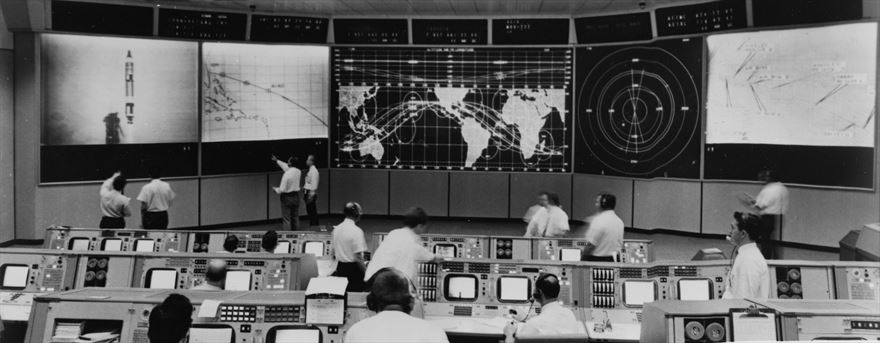Ford news

QuickPic | July 23, 2019
Space Oddity: The Surprising Story of How Ford Helped Put a Man on the Moon
- Ford Motor Company had a huge hand in the Apollo 11 mission equipment which enabled the mission, including the voice transmission back to Houston.
- Ford Motor Company purchased a company, Philco in 1961 and transferred its Aeronutronic Division to a new entity and called it Philco-Ford.
- Philco-Ford’s was renamed in 1976 to Ford Aerospace and Communications Corporation. Ford Aerospace had built more than half the communications satellites in orbit.
PRETORIA, South Africa, 23 July 2019 – “Houston, Tranquility Base here. The Eagle has landed.” As Neil Armstrong’s words reverberated throughout the NASA Mission Control Center in Houston, and cheers and celebrations erupted both at Mission Control and around the world. The Apollo 11 lunar module had just landed on the moon.
Fifty years after that fateful moment, there isn’t much about the moon landing that has escaped our collective knowledge. But one thing that might surprise people is that Ford Motor Company had a huge hand in the Apollo 11 mission. All of the equipment that enabled the mission — including the voice transmission back to Houston and out to the rest of the world — was possible because of Ford’s role in building and maintaining the Mission Control Center.
How did the company that put the world on wheels come to be a part of putting a man on the moon?
From Carbon Arc Lamps to the Space Race
The story begins with Philco, founded in 1892 to produce carbon arc lamps before shifting into battery, radio and television production. In 1953, Philco engineers invented the surface barrier transistor, the first high-frequency transistor that enabled the development of high-speed computers. Philco’s effort to miniaturize and perfect the transistor led to work with the U.S. Military and NASA, but by 1960 financial difficulties forced the company to seek an outside buyer.
Looking to expand its product offerings beyond the automobile industry, Ford was intrigued by the access to new and innovative technologies engineered by Philco. It purchased the company in 1961 and Ford transferred its Aeronutronic Division to a new entity it called Philco-Ford.
In 1963, the company went head-to-head against tech giants like IBM, RCA, Lockheed, Hughes Aircraft and AT&T in a bid to implement the Mission Control Center at the new Manned Space Center in Houston. Although Philco-Ford was considered an underdog in the process, it was ultimately awarded the role as prime contractor.
“Had it not been for the merger with Ford, the company most likely would not have been considered for the job because of the magnitude of the engineering resources required,” Walter LaBerge, manager of Philco-Ford Houston Operations, noted in an oral history recounting the project.
Building What Had Never Been Built Before
The job responsibilities for Philco-Ford were immense, encompassing the design of hardware and software systems to solve problems that had never been experienced before, plus manufacturing, installation, start-up and testing of the control center, including data and control links to NASA’s remote tracking sites.
“In short, what NASA needed on the ground to assure a landing on the moon in the 60s was a major computer-assisted decision-making capability which no one had when Philco-Ford received the contract,” reads a company document from the time.
The Mission Control Center was completed in about two years — just in time to monitor the Gemini 3 mission in March of 1965 — and was fully functional a few months later when all mission control operations were moved from Cape Kennedy to Houston’s Manned Space Center.
In addition to designing and building out the control center, Philco-Ford provided technical and engineering support personnel during construction and ongoing operations. The system designs were updated for each mission, some of which required as many as 2 million wiring changes. Other statistics from Mission Control are just as staggering now as when they were installed more than 50 years ago:
- More than 1,500 different items of telemetry data — from an astronaut’s health to the results of tests and flight data — flowed into the center simultaneously.
- The Mission Control Center housed the largest assembly of television switching equipment in the world.
- More than 60,000 miles of wiring were laid and maintained to continue operations.
- Five IBM 360/75 mainframe computers sent data to more than 1,300 indicator switches to be monitored by mission flight controllers.
The Journey to the Moon
While Philco-Ford was involved with all of the Apollo missions, two stand out for their complexity.
The Apollo 8 mission featured the first spacecraft to orbit the moon and return to earth. This mission presented serious challenges to the personnel and equipment at the Mission Control Center because signals and data would be lost as the craft went behind the moon during the lunar orbit. There were some concerns about how the signal would be reacquired, but the equipment worked flawlessly and even allowed the astronauts to make several broadcasts from space — including a message of peace on Christmas Eve 1968.
In July 1969, Apollo 11 was the focus of the world. The work by Philco-Ford and the Mission Control staff was even more complex due to the unprecedented nature of the mission. As the world held its breath on July 20, the descent to the moon’s surface was broadcast around the globe.
The astronauts conducted a series of experiments and gathered lunar surface materials. They deployed the Early Apollo Scientific Experiments Package (EASEP), which would remain on the moon and monitor environmental conditions. The EASEP was a joint effort of NASA, Philco-Ford and IBM, so even after the successful return of the astronauts on July 24, 1969, the experimental package would remain and broadcast data for another year.
Life After the ‘Giant Leap’
Philco-Ford’s role with Mission Control continued as the Apollo missions gave way to Skylab, Apollo-Soyuz and eventually the Space Shuttle. Renamed Ford Aerospace and Communications Corporation in 1976, the company also began to provide additional services in satellite communication, including high-speed information systems with communication and environmental satellites. At one point in the early 1980s, Ford Aerospace had built more than half the communications satellites in orbit.
In 1990, Ford Motor Company exited the aerospace industry when Ford Aerospace was sold to Loral Corporation, but the same spirit of curiosity and innovation that powered its aerospace endeavors is still alive and well today. With major investments and advancements in self-driving technology, connected and electrified vehicles, as well as a major initiative to connect our transportation systems to a more efficient network, Ford is actively working to harness the power of technology to help cities overcome their own unique challenges. We’ve put our heads down to create groundbreaking technology before, and that gives us the confidence to know we can do it again to make life better for all, right here on earth.
Meanwhile, the Mission Control Center became a symbol of the space race recognized around the world, with historian Layne Karafantis describing it as “the most famous iteration of a particularly mid-century technology: the global Control Center.”
“The MCC in Houston, filled with consoles and computers and displays of real-time data, became iconic,” she continued. “MCC was a dynamic space whose design was created and implemented with almost every possible contingency considered. The Philco-Ford team’s integration of display, communication, and data-processing technologies within the Center made a manned mission to the Moon possible.”
Just like the rest of the world, Henry Ford II watched star-struck when that mission proved successful, inspired by its magnitude — and by what it could also mean for our terrestrial future.
“Only a few generations ago, most men lived and died within a few hundred miles of their birthplaces,” he said in a statement. “Now our horizons are virtually limitless. If man can walk on the moon, he can look to the planets and beyond the solar system as Columbus must have looked across a forbidding ocean… If we show the same determination and willingness to commit our resources, we can master the problems of our cities just as we have mastered the challenge of space.”
Original article & image as supplied by QuickPic











